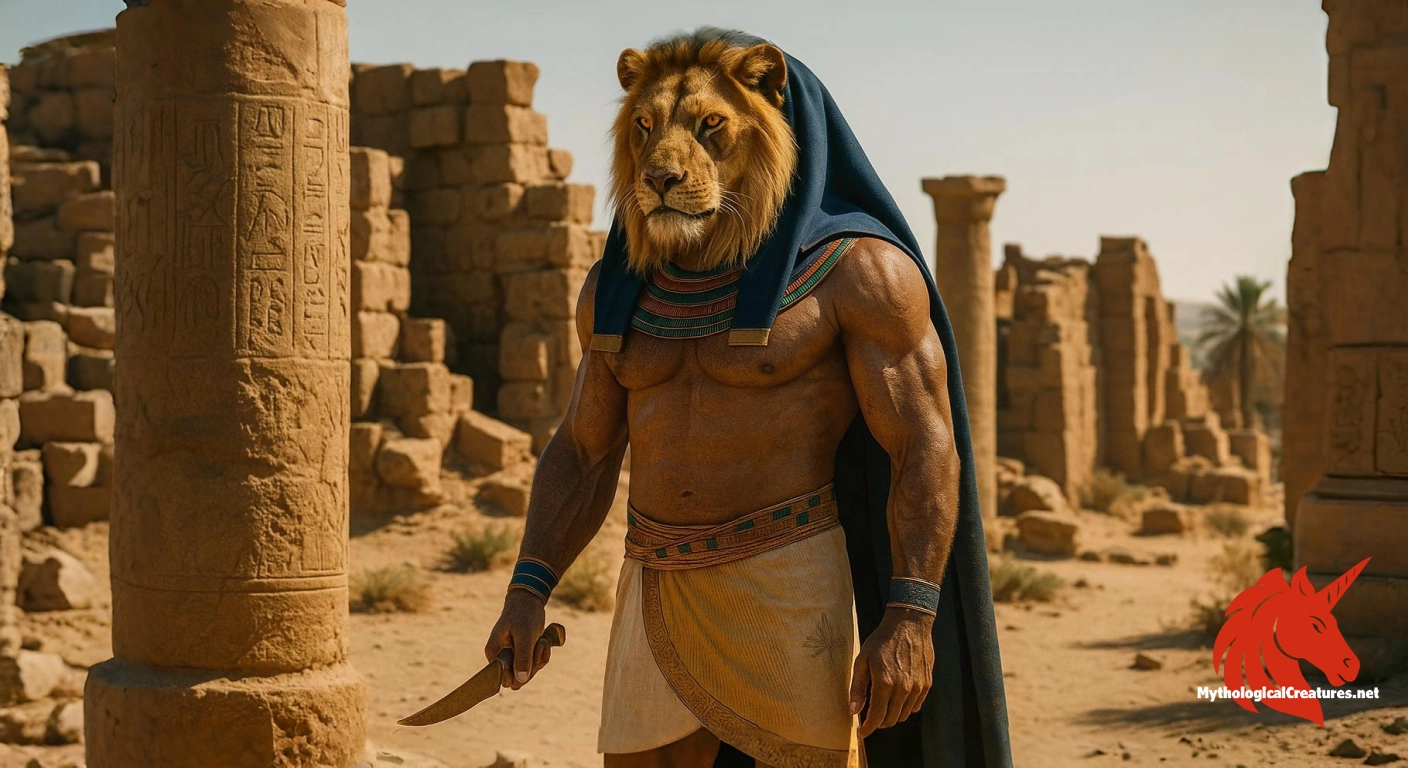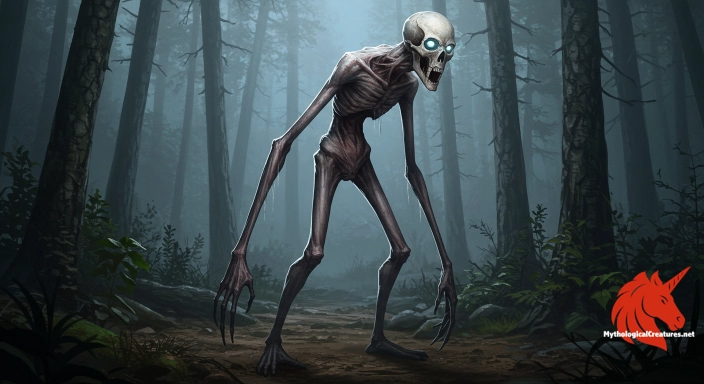Maahes: Maahes is an ancient Egyptian lion-headed god of war known for his fierce combat prowess and protective nature.

Maahes
Maahes - Maahes played a crucial role in ancient Egyptian warfare and religious practice, embodying both the destructive and protective forces associated with the lion and war.
Origins & First Encounters
Maahes is renowned in ancient Egyptian mythology as a formidable lion-headed deity whose presence was deeply intertwined with the arts of war and protection. He is traditionally portrayed as the son of the creator god Ptah and inherits aspects of the fierce feline goddesses Bast and Sekhmet, making him an embodiment of both martial prowess and maternal strength. His name, which conveys the idea of being "true beside her," alludes to his role as a steadfast guardian in the divine order. Emerging during a period when Egypt’s religious practices emphasised the synergy between human and animal attributes, Maahes soon established himself as a protector of both the battlefield and the natural elements. His early attestations can be found in temple inscriptions and cultic centres such as Taremu and Per-Bast, where his character resonated with local populations. The integration of his combative spirit with the nurturing aspects inherited from his mother figures invited pilgrims and warriors alike to seek his blessing. His iconography, steeped in both ferocity and benevolence, symbolised the balance between destruction and renewal. Over time, his narrative grew to represent not just the chaos of battle but also the order and protection that followed. This duality in his character ensured that Maahes remained a potent symbol across different eras of Egyptian history.
Source Texts & Tale Variants
Ancient Egyptian temple walls and papyri provide a fragmented but intriguing view of Maahes, revealing a god whose stories were told through ritual inscriptions and artistic depictions. Multiple sources reference his role as a divine warrior in isolated cult texts, with some texts focusing on his martial might while others highlight his protective capacity. Although not always the subject of extensive mythological narratives, his attributes were interwoven with local ritual practices as seen in temple reliefs and funerary texts. Greek writers adopted variations of his name—such as Mihos and Mahes—illustrating a cross-cultural exchange of mythological ideas. In some accounts, his battles against chaos are depicted in allegorical terms, blending historical events with mythic symbolism. Variations in the surviving texts indicate that his myth was adapted and reinterpreted over time to meet local spiritual needs. Some inscriptions hint at a complex familial relationship that emphasised his divine heritage from Ptah and a close affiliation with the fierce goddesses. These diverse sources, spanning from formal mythic compilations to popular local legends, collectively contribute to our understanding of Maahes as a multi-faceted deity. His representation in both hieroglyphic and Greek-influenced texts underlines the breadth and reach of his cultic significance.
Form & Powers
Maahes is most commonly depicted with a lion’s head seamlessly integrated onto a predominantly human body, a design that captures both regal beauty and dangerous strength. His facial features are rendered with meticulous care, showcasing sharp eyes, a pronounced mane, and an expression that balances both ferocity and wisdom. In artistic renditions, his body is well-muscled, reflecting the vitality and power necessary for a deity of war. Consistent attributes such as an erect posture, a stylised uraeus, and often a symbolic weapon further emphasise his martial nature. Variations in his depiction sometimes include ornamental elements that symbolise his association with weather phenomena and ritual knives. Detailed carvings from temple reliefs evoke a sense of movement and alertness, suggesting that he is ever-vigilant against the threats of chaos. Some statues present him with a crown or other regalia that underlines his divine authority and his close ties to both highly esteemed creator and warrior deities. The dynamic contrast between his human form and leonine head is artistically rendered to reflect dual themes of wisdom and raw instinct. Over centuries, his physical iconography has remained remarkably consistent, ensuring that his recognisable form endures in both ancient and modern representations.
Regional Faces
Regional depictions of Maahes demonstrate fascinating variations that often reflect local religious and cultural influences. In Lower Egypt, his character was closely associated with the gentle yet protective traits of Bast, lending him a slightly softer cultural narrative. Conversely, in Upper Egypt, the influence of the more ferocious Sekhmet accentuated his aggressive and martial aspects. These regional adaptations are evident in the stylistic differences of temple art and local ritual practices where his iconography sometimes shifts from an abstract guardian to a vivid symbol of untamed battle prowess. Local priesthoods and regional communities adapted his myth to respond to contemporary social and political needs, thereby altering his narrative emphasis. In some localised traditions, rituals dedicated to him would highlight his role as a mediator between human society and the unpredictable forces of nature. The interplay between his warlike features and the nurturing undertones inherited from his divine lineage enabled diverse communities to relate to him in uniquely personal ways. Artefacts and mural paintings from different parts of Egypt reveal a pattern of syncretism, where his image merged with local deities to form composite figures. This regional dynamism ensured that while the core attributes of Maahes remained recognisable, his cultural manifestation varied beautifully from one locale to another.
Cultural Parallels
When compared with other mythological figures, Maahes stands out as a prime example of the blending of animalistic and human characteristics that symbolise both strength and wisdom. His lion-headed iconography finds echoes in other cultures, where lions are similarly revered as emblems of power and guardianship. Figures such as the Mesopotamian lamassu or even certain aspects of the Greek sphinx share the motif of combining human intelligence with the raw strength of a lion. This cross-cultural motif underscores a broader ancient tradition of venerating the lion as a symbol of royal authority and divine protection. In many ways, Maahes embodies the universal archetype of the warrior deity who bridges the gap between mortal frailty and cosmic might. The blending of combativeness with protective tenderness in his character is reminiscent of other lion deities found across the ancient Near East and the Mediterranean. Such parallels are not merely superficial; they highlight how different cultures used similar imagery to express essential truths about the human condition and the nature of divine intervention in warfare. Across diverse mythologies, these figures often served as both fearsome champions and benevolent protectors, a duality that finds its perfect embodiment in Maahes. His enduring imagery has thus contributed to a shared symbolic language that transcends geographical boundaries.
Legacy & Modern Evolution
The legacy of Maahes has evolved significantly over the millennia, adapting to shifting cultural and artistic paradigms. During ancient times, his image was a powerful emblem of military might and protective strength, frequently invoked by warriors and rulers to inspire both fear and respect. As Egyptian religious traditions merged with Greco-Roman influences, his visual and symbolic language began to take on additional layers of interpretative meaning, reflecting broader notions of cosmic order. In medieval and later periods, his image occasionally surfaced in the artistic and intellectual revival of ancient motifs, often symbolising the enduring battle between order and chaos. Today's interpretations of Maahes in modern art, literature, and even popular culture tend to highlight his dual role as both a fearsome warrior and a compassionate guardian. His lion-headed visage continues to inspire contemporary reimaginings, appearing in diverse media that range from museum exhibitions to graphic novels. Modern scholars regard him as a fascinating study in the evolution of myth, one whose themes of protection, resilience, and the interplay of creation and destruction remain eternally relevant. His influence persists not just in academic circles but also in the collective imagination, where ancient divine power is reinterpreted to address modern existential concerns. The transformation of Maahes over time encapsulates the timeless nature of myth and its ability to speak to the human spirit across ages.
Interesting Fact
An intriguing aspect of Maahes is his dual lineage, which fuses the divine attributes of Ptah with the fierce, lioness-associated qualities of Bast/Sekhmet, encapsulating the dual themes of destruction and protection in Egyptian mythology.
Quick Creature Info
Origin:
Features:
Associations:
Our Mythic Legendary Rating:

Also Sometimes Known As:
Habitat:
Supernatural Powers:
Physical Attributes:
Abilities:
Behavior:
Lore:
References
Discover Another Mythical Legend You May Not Have Heard Of?
Uncover the mysteries of ancient folklore and expand your knowledge of legendary beings from cultures around the world.
Dare to Meet the Baykok....
Mythical Disclaimer: The images and data on this site are derived from various historical and literary sources, but we have found that many myths often have multiple versions and interpretations across references, sometimes contradictory. As a result, these creature depictions are artistic interpretations—imaginative blends of folklore, legend, and a dash of AI guesswork. Because creature descriptions vary widely, our illustrations and accompanying information represent our best effort to honor mythology while bridging creative gaps. Enjoy these interpretations—just remember, we've done our best to respect the stories and validate available data, but in the realm of mythology, details often shift, imagination leads the way, and nothing is ever set in stone!
Curated by the Mythological Creatures Team (rev. May 2025)
